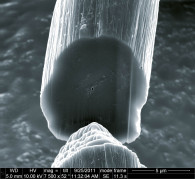
It looks like black cotton thread, but it conducts electricity and heat like a metal wire and is as strong as carbon fibers. This next-generation nanotechnology has emerged from the intertwined efforts of top-tier researchers from Rice University, Houston, Texas; Teijin Aramid, Amhem, The Netherlands; the Technion-Israel Institute of Technology, Haifa, Israel; and the Air Force Research Laboratory in Dayton, Ohio, U.S.A. With features that include the flexibility of textile thread, 10 times the tensile strength and conductivity of previously reported carbon nanotube (CNT) fibers, and electrical conductivity on a par with copper wire, the potential applications are sending shock waves through the industry.
In 2009, a Rice University graduate student, Natnael Bahabtu, found simple ways to spin CNT fibers from chlorosulfonic acid solutions. “No one thought that spinning out of chlorosulfonic acid was possible,” says Matteo Pasquali, lead researcher and professor of chemical and biomolecular engineering and chemistry at Rice. “That was critical for the new process.” Teijin Aramid’s expertise in producing long CNTs, coupled with the new discovery, led Teijin to fund a project with Rice University. The Air Force
Research Laboratory scientists joined the project to measure the precise electrical and thermal properties of the improved fibers. Technion-Israel worked on the tight-packing and alignment issues that are essential to the fibers’strength and conductivity.
“Metal wires will break in rollers and other production machinery if they are too thin,” says Pasquali. “In many cases, people use wires that are far more thick than required for the electrical needs.” The highly conductive, flexible and thin CNTs may lead to revolutionary size, weight and cost reductions for aerospace, automotive, medical and smart clothing technologies.

 TEXTILES.ORG
TEXTILES.ORG


